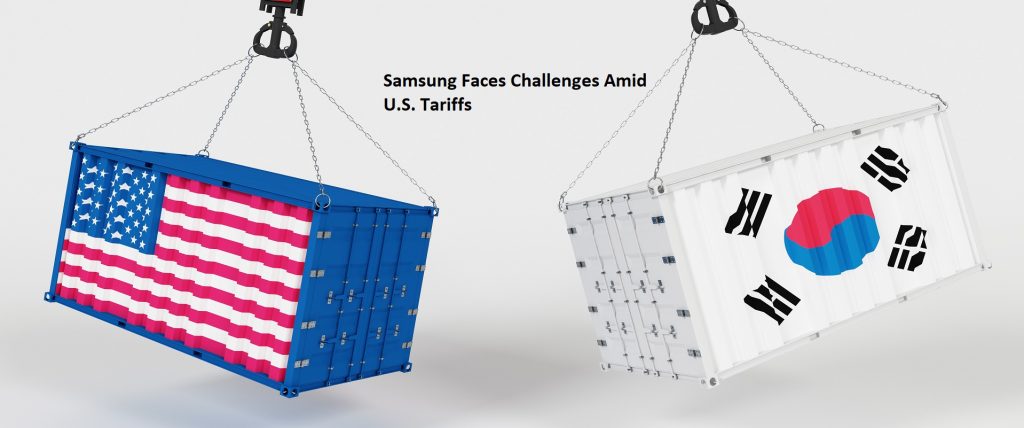The global trade landscape is undergoing seismic shifts as U.S. President Donald Trump enforces sweeping tariffs on imports, targeting countries like South Korea and Vietnam. These measures, aimed at reshaping global supply chains, have placed companies like Samsung Electronics under immense pressure. As the world’s second-largest smartphone manufacturer and a key player in consumer electronics, Samsung’s response to these tariffs will have far-reaching consequences for South Korea’s economy and the broader tech industry.
Tariffs Shake Up Samsung’s Global Supply Chain
Samsung Electronics has long relied on its diversified global production network to maintain its competitive edge. The company produces over 50% of its smartphones in Vietnam, with additional manufacturing hubs in India, Brazil, Indonesia, and South Korea. However, the newly imposed tariffs—ranging from 25% for South Korean goods to 46% for Vietnamese imports—are threatening this strategy.
For instance:
- Vietnam faces a 46% tariff on goods entering the U.S., significantly impacting Samsung’s smartphone production.
- India, another key manufacturing hub, faces a 26% tariff.
- Mexico remains exempt from these tariffs, offering some relief for Samsung’s TV production.
These tariffs could cost Samsung approximately 4 trillion won ($2.7 billion), or 33% of its smartphone operating profit if fully absorbed1. This financial strain underscores the broader vulnerability of export-driven economies like South Korea.
Economic Fallout in South Korea
South Korea’s economy is heavily reliant on exports, which accounted for over 90% of its total economic growth in 20241. The U.S. tariffs have not only targeted electronics but also other key sectors like automotive manufacturing. For instance:
- A 25% tariff on imported vehicles is expected to cost South Korean automakers billions of dollars annually.
- The government has announced emergency measures, including $10 billion in financial support for automakers and tax incentives to stimulate domestic consumption.
Despite these efforts, experts warn that the country’s export-focused conglomerates need more robust support to weather the storm.
Samsung’s Strategic Response
To mitigate the impact of these tariffs, Samsung is leveraging its global production network. The company plans to reallocate production based on tariff conditions:
- High-end TVs sold in North America are primarily produced in Mexico, avoiding U.S. tariffs altogether.
- For smartphones and other electronics, Samsung is expanding its lineup of mid-range and entry-level products to maintain competitive pricing.
However, relocating production entirely to tariff-free zones like Mexico or the United States could be an inevitable long-term strategy. This move would involve significant costs but may be necessary to sustain market share in the strategically vital U.S. market.
Comparative Advantage Over Apple?
While Samsung grapples with these challenges, it may still hold a comparative advantage over its chief rival, Apple. Apple manufactures roughly 90% of its iPhones in China, which now faces a staggering 54% effective tariff under Trump’s policies. In contrast, Samsung’s diversified production base could help it weather the storm more effectively.
However, experts caution that Apple’s close relationship with the Trump administration could lead to exemptions or favorable policies, further complicating the competitive landscape.
Broader Implications for Global Trade
The ripple effects of these tariffs extend beyond individual companies:
- Supply Chain Disruptions: Many businesses are rejecting shipments due to skyrocketing costs, leading to abandoned freight at ports and potential inventory shortages.
- Consumer Impact: Higher import taxes are driving up prices for electronics and other goods. For example, footwear prices have surged by over 100% due to similar tariff policies.
- Shift in Manufacturing Trends: Companies may increasingly relocate production to countries with favorable trade agreements or even back to the United States.
What Lies Ahead?
The current situation presents both challenges and opportunities:
- For Samsung and other South Korean companies, adapting to this new trade environment will require significant investment in automation and localized production.
- The South Korean government must take proactive measures to negotiate more favorable trade terms while supporting domestic industries through subsidies and tax breaks.
In the longer term, these developments could accelerate a shift toward more regionalized supply chains as companies seek to minimize exposure to geopolitical risks.
The U.S. tariffs have placed Samsung Electronics at a crossroads, forcing it to rethink its global manufacturing strategy while navigating unprecedented economic pressures at home. As one of South Korea’s largest conglomerates, Samsung’s ability to adapt will not only shape its own future but also influence the trajectory of South Korea’s export-driven economy.
With global trade policies becoming increasingly unpredictable, flexibility and innovation will be key for companies like Samsung to thrive in this challenging environment.
#Samsung #USTariffs #SouthKoreaEconomy #GlobalTrade #SupplyChainDisruption #TechIndustry

